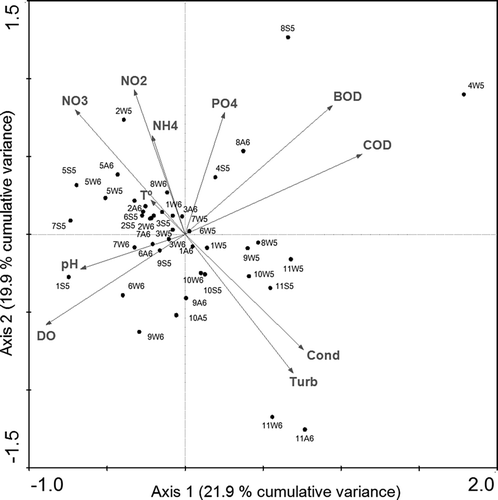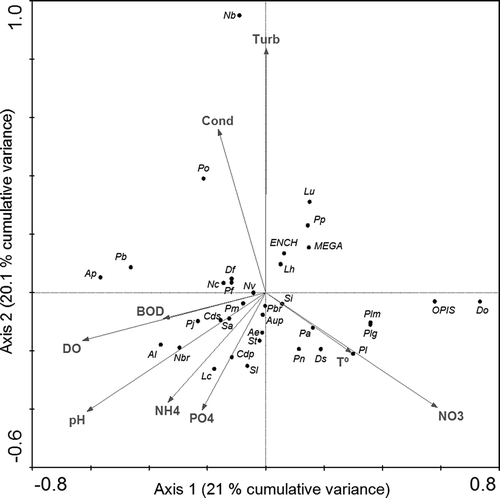Abstract
The oligochaete assemblage on the Argentine coast of the Río de la Plata estuary was sampled seasonally within environments having different types of disturbances. Three habitats were sampled: sediments free of vegetation, sediments within bullrush stands and substrates with Limnoperna fortunei. The species richness, evenness and Shannon–Wiener diversity values were different among those habitats. The only dominant species (according to the Kownacki index) was Nais variabilis. Mean density values varied between 400 and 199,500 ind./m2. Organic matter, ammonium and phosphates correlated positively with the mean oligochaete abundance, but not with the granulometry. Physicochemical variables and nutrient levels were measured and their relation to the sampling sites assessed through a principal component analysis (41.8% cumulative variance). The canonical correspondence analysis (41.2% cumulative variance) indicated that the oligochaetes distributed along both a eutrophication–pollution gradient and a turbidity–conductivity gradient. These results would be useful for assessing the ecological status of estuaries for a subsequent implementation of appropriate sustainability-management policies.
Introduction
The Río de la Plata estuary constitutes an ecosystem of great socio-economic relevance, representing one of the main navigation routes of South America and a major provider of potable water. Since the city of Buenos Aires and extensive suburbs lying along its banks constitute one of the major areas of urban concentration in Argentina, the river is continually subjected to high anthropogenic pressure. This estuary thus suffers from a number of environmental insults, ranging from the input of organic matter and consequent nutrient enrichment resulting from agricultural and cattle-raising enterprises to contamination with waste products from urban and industrial activities. Greater Buenos Aires is a zone where extractive, recreational and port activities coincide with effluxes of industrial and urban wastes and is the location of natural reservoirs and ecological threatened habitats that must be protected for the conservation of biodiversity (Canevari et al. Citation1999). Nevertheless, despite these ecologically urgent considerations, the information necessary for directing the sustainable management of the river's biotic resources is still lacking (Gómez & Rodrigues Capítulo Citation2000), and only in recent times have the authorities begun to establish the appropriate policies for that evaluation.
The macroinvertebrates in the Río de la Plata River have been studied by a number of authors (Darrigran et al. Citation1998; Darrigran & López Armengol 1998; Rodrigues Capítulo et al. Citation1998, Citation2004; César et al. Citation2000; Cortelezzi et al. Citation2007), while the species composition and ecological requirements of oligochaetes in particular have been analysed during recent years in other larger rivers in South America (Montanholi-Martins & Takeda Citation1999; Takeda Citation1999; Ezcurra de Drago et al. Citation2004; Marchese et al. Citation2005). Furthermore, in various parts of the world, studies on the oligochaete fauna from temperate estuaries subjected to anthropogenic impact have indicated that the most significant environmental factors affecting their distribution are the salinity, turbidity, discharge, trophic condition, sediment characteristics and general quality of the bodies of water in question (Moroz Citation1994; Finogenova Citation1996; González-Oreja & Saiz-Salinas Citation1999; Seys et al. Citation1999).
In contrast, little is known about the oligochaete species of the estuary system of the Río de la Plata; nor have these annelids yet been placed under intensive scrutinisation despite their prominent presence within the river's invertebrate fauna and their potential usefulness as indicator organisms to assess the state of well-being of the aquatic ecosystem. The objective of this investigation was, therefore, to describe the composition and spatial distribution of the aquatic oligochaetes in the Argentine freshwater tidal zone of the Río de la Plata with an aim of establishing key background information on them that can eventually serve to evaluate the ecological state of the river for future use in the establishment of sustainability-monitoring practices.
Material and methods
Study site
The Río de la Plata estuary receives all the water from the river's extensive basin of about 3.1 million square kilometres—encompassing territories within Argentina, Bolivia, Brazil, Paraguay and Uruguay—and especially from the Paraná and Uruguay rivers, its major tributaries (OAS Citation1971). The river is 320 km long and 220 km wide at its mouth on the Atlantic Ocean; its total surface has been estimated at 30,000 km2 and its flow at 23,000 m3/s. After Boschi (Citation1988), the river is divided into three sections according to the depth and degree of marine influence on the water salinity: the upper section—extending down to the imaginary line joining Punta Lara (Argentina) at 34°50'S, 57°53'W and Colonia (Uruguay) at 34°28'S, 57°51'W—is characterised by shallow waters (2–5 m) with very low salinity (0.3); the middle section—between Punta Piedras (Argentina) at 35°27'S, 56°45'W and Montevideo (Uruguay) at 34°55'S, 56°13'W—is of depths between 6 and 7 m and salinities between 0.3 to 5; and the outer section—between Punta Rasa (Argentina) at 36°22'S, 56°46'W and Punta del Este (Uruguay) at 34°58'S, 54°56'W—has a depth ranging from 6 to 16 m and salinities from 5 to 25.
In addition to hydrophytes, the Argentine coast of the Río de la Plata is dominated by two types of natural substrates: soft substrata, formed by fine sand, silt and clay, and hard substrata formed over a mantle of caliche that can outcrop throughout certain areas forming a littoral cord (Urien Citation1967; Boschi Citation1988; Darrigran & López Armengol Citation1998).
Sampling of oligochaetes
Seasonal samplings were performed in winter and spring 2005, and in autumn and winter 2006 at 11 sites along the Argentine coast of the Río de la Plata estuary, located between 34°29'S, 58°28'W (at the mouth of the Luján River) and 35°16'S, 57°13'W (the cape Punta Indio), thus covering a stretch of approximately 220 km of shoreline (). This section of the estuary system corresponds to the geomorphologic unit known as Franja Costera Sur and is a freshwater zone (conductivity values <5000 µS/cm), though subjected to the influence of the Atlantic Ocean tides. The following littoral environments with different types of ecologic disturbances (after Gómez et al. Citation2009) were selected: Sites 1, 2 and 3, corresponding to highly urbanised areas with navigational and port activities as well as receiving domestic and industrial effluent discharges; Site 4, constituting a highly impacted area where industrial-effluent discharges predominate; Site 5 in close proximity to the sewage discharge of Buenos Aires city; Sites 6 and 7, protected and recreational areas, respectively, but influenced by poor water quality from human activities upstream; Site 8, located close to other major sewage discharges; and Sites 9, 10 and 11, consisting in areas only slightly impacted (thus considered here as ‘reference sites’)—where Site 11, for its part, is the closest to the maximum turbidity front. Site 4 was sampled only during the first two seasons because of coastal alterations stemming from urban development. All sampling was undertaken within the intertidal zone.
Figure 1 Map of the Río de la Plata estuary system showing the sampling sites. S1, the mouth of the Luján river; S2, San Isidro; S3, the airport of the city of Buenos Aires; S4, Santo Domingo; S5, Berazategui; S6, Boca Cerrada; S7, Punta Lara; S8, Bagliardi; S9, Balandra; S10, Atalaya; S11, Punta Indio. In grey: large urban areas; striped: protected natural areas.
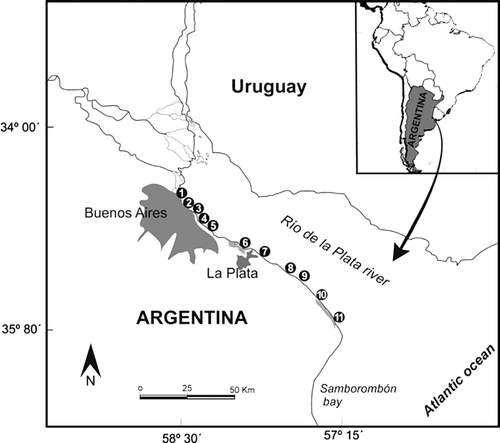
At each sampling opportunity, three replicates (Ekman grab, 100 cm2) were taken of sediments free of vegetation (sfv) and of sediments within stands of the bullrush Scirpus californicus (C.A. Meyer) Steud. (swb). When present, substrates with settlements of the invasive mussel Limnoperna fortunei (Dunker, 1857) (sLf) were taken manually covering an area similar to that of the grab. Samples were fixed in the field with 5% (v/v) formaldehyde. For the estimation of organic matter, samples from the first centimetres of the sediment were taken with a core (area 3 cm2). The turbidity plus the temperature, pH, conductivity and dissolved-oxygen levels were recorded in situ with a Turbidity meter 800-ESD and a Horiba Water Quality Checker U-10, respectively. Water samples were also collected for nutrient analysis (NO3 -, NO2 -, NH4 + and soluble reactive phosphorous, PO4 3-) as well as for biochemical and chemical oxygen demand (BOD5 and COD).
In the laboratory, the granulometry analysis was carried out and classified according to the categories proposed by Folk (Citation1974): clay (≤3.9 µm), silt (3.9–62.5 µm) and sand (>62.5 µm). Organic matter, expressed as ash-free dry weight, was measured as the difference in weight between the dried mass at 60°C for 48 h and combusted mass at 550°C for 4 h (APHA Citation1998).
The benthic samples were washed on a 250-µm mesh sieve and stained with erythrosin B. The oligochaetes were sorted from the rest of the zoobenthos under a stereoscopic microscope and classified under a compound microscope according to Brinkhurst & Marchese (Citation1992), Erséus & Gustavson (Citation2002), Opinion 2167 ICZN (Citation2007) and Glasby & Timm (Citation2008). The Enchytraeidae were determined only to the family level since the appropriate keys are not available. Oligochaetes were subsequently preserved in 70% (v/v) aqueous ethanol.
Data analysis
A two-way analysis of variance (ANOVA) test was performed to evaluate the fluctuations in each environmental variable recorded: the seasonal variation was analysed using the sampling dates as multiple input data and the spatial variation using the sampling sites as multiple input data.
The oligochaete assemblage was evaluated on the basis of the diversity index (Shannon & Wiener Citation1963), the evenness and the species richness. To analyse the differences registered at each sampling site among the three types of habitats sampled (the sfv, swb and sLf) one-way ANOVA tests were performed. The dominance index of Kownacki (Citation1971) was also calculated and applied.
Pearson's correlation coefficient was used to analyse the relationships between: (1) the nutrient concentration vs the oligochaete total abundance, (2) the percentage organic matter vs the oligochaete mean density, and (3) each of the sediment particle sizes considered in this study vs the oligochaete mean density.
Two-way ANOVA tests was performed to analyse the seasonal and spatial variations of the oligochaete total densities [loge (x+1)].
Where statistically significant differences were found in the ANOVA tests performed, subsequent Student–Newman–Keuls tests were applied (Underwood Citation2007).
The relationship between the sampling sites and the standardised physicochemical variables measured was explored through the principal component analysis (PCA). The detrended correspondence analysis (DCA) by segments was used in the biotic data to determine if the species responded linearly to gradients or passed through some environmental optimum. Since the maximum gradient length in standard deviation units obtained in this analysis was 3.45, we assumed a unimodal response model for the species. We therefore decided to use a canonical correspondence analysis (CCA) to explore the relationship between the oligochaete abundance and the environmental variables recorded at the sampling sites (ter Braak & Verdonschot Citation1995). The species abundances were loge(x+1)-transformed and all taxa included except inmature forms of Limnodrilus spp (referred to as Tin; cf. ). The physicochemical variables were standardised. Their variance-inflation factors were found to be <4. The COD and NO2 - were excluded because their test for significance had failed (P=0.124 and P=0.656, respectively; ter Braak & Verdonschot Citation1995). The significance of all canonical axes was evaluated through the Monte Carlo test (499 permutations under the reduced model, P<0.05). The first two axes of the ordination were selected for graphical representation.
Table 1 List of oligochaete species collected at the sampling sites in the Río de la Plata estuary (Argentina), with the abbreviation of each species and the dominance-index category defined according to Kownacki: dominant (10–100), subdominant (1–9.99), adominant A (0.1–0.99) and adominant B (0–0.099).
Results
Physical and chemical quality of the water
Many physicochemical variables recorded exhibit major fluctuations over the area studied, a characteristic in keeping with estuarial environments. gives the mean values and their ranges. The ANOVA tests performed to evaluate the seasonal variation showed statistically significant differences in temperature (P<0.001), dissolved-oxygen levels (P=0.004), COD (P=0.006) and BOD5 (P=0.032). The water temperature exhibited a seasonal patterntypical of temperate climates, ranging between 14.1° and 29.2°C in winter and the end of spring, respectively. Of the spatial variations tested, all environmental variables analysed exhibited statistically significant differences, except for temperature (P=0.962) and NH4 + (P=0.346). Moreover, a gradient of turbidity and conductivity were found (A and b): turbidity was the highest in the outer estuary (P<0.001), while the conductivity also increased in the same direction (P<0.001) and was elevated at those sites with industrial or domestic discharges as well (e.g. Sites 4, 5 and 8). Site 4, characterised by low water quality because of industrial effluents, evinced the highest BOD5 and COD values and the lowest dissolved-oxygen levels (0.3 mg/l). The pH varied between 7.2 and 9.4 both in spring. The lowest NO3 − values (0.04 mg/l) were registered in autumn at Site 11, while the highest (1.45 mg/l) were recorded in spring, at Site 7; the NO2 - and PO4 3- levels reached a maximum (0.34 and 1.34 mg/l, respectively) at Site 8, where a major sewage-discharge area is located; the highest NH4 + values (1.37 mg/l, Site 2) were registered in a densely populated area.
Figure 2 A, Turbidity and B, conductivity: mean±standard deviation values measured over the sampling area.
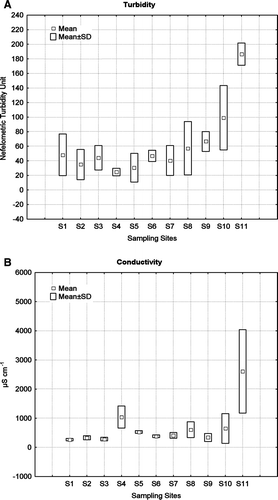
Table 2 Mean values of physicochemical variables measured at the sampled sites in the Río de la Plata estuary (Argentina); minimum and maximum values are indicated between brackets.
Oligochaete-assemblage structure
The ANOVA tests performed to analyse differences registered at each sampling site with respect to the diversity index, the species richness and the evenness indicated: (1) statistically significant differences (P<0.05) between sfv and swb for all three parameters; (2) no statistically significant differences (P>0.05) between swb and sLf for all three; and (3) statistically significant differences between sfv and sLf in species richness (P=0.001) and diversity index (P=0.006), but not in evenness (P>0.05). The oligochaete species richness varied between 1 and 21, with the highest values being recorded at the locations closest to major sites of sewage discharge (Sites 5 and 8), as well as in the samples of sediment associated with L. fortunei (). Moreover, the diversity varied between 0 (Site 11 in autumn 2006) and 2.02 bits/ind (Site 2 in autumn 2006), with relatively similar values over the entire sampling period (). During the winter of 2005, Limnodrilus hoffmeisteri was found only at Site 7. The evenness ranged between 0.33 (Site 11 in autumn 2006) and 0.97 (Site 5 in winter 2005), while the largest fluctuations were recorded in autumn 2006.
Figure 3 Richness (R), evenness (E) and Shannon–Wiener diversity (H, bits/ind) indices of oligochaetes in the Río de la Plata estuary system during 2005–2006. 1–11: sampling sites. *Samples including settlements of Limnoperna fortunei.
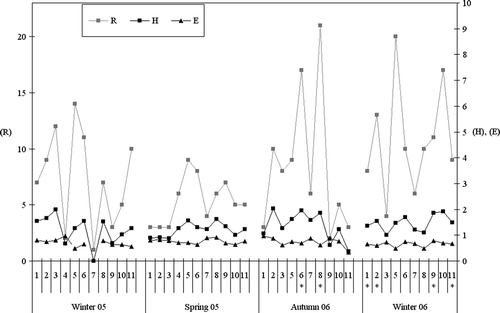
According to the Kownacki index, the only dominant species in the locations sampled was Nais variabilis (); accompanied by Paranais frici, Chaetogaster diastrophus, Nais communis, L. hoffmeisteri, immature tubificinae (without capillary chaetae) and the Enchytraeidae as subdominant taxa. Additionally, a significant number of rare species—such as Pristina biserrata, Dero obtusa, Narapa bonettoi and Allonais paraguayensis—were also registered.
Pearson's correlation coefficients showed: (1) a positive relationship between oligochaete total abundance vs NH4 + (r=0.489, P=0.03) and PO4 3- (r=0.324, P=0.03) concentrations, whereas no correlations were observed with respect to NO3 - and NO2 - concentrations (P>0.05); (2) a positive relationship between oligochaete mean density vs the average percentage organic matter (r=0.698, P=0.017); and (3) no relationship between each of the sediment particle sizes considered and oligochaete mean density (P>0.05). A and B show the variations in mean abundance of oligochaetes in relation to the average percentage organic matter and particle size, respectively.
Figure 4 A, Relationship between the mean abundance of oligochaetes and the organic matter registered in the sampling sites. B, Sediment particle-size values in the sampling localities.
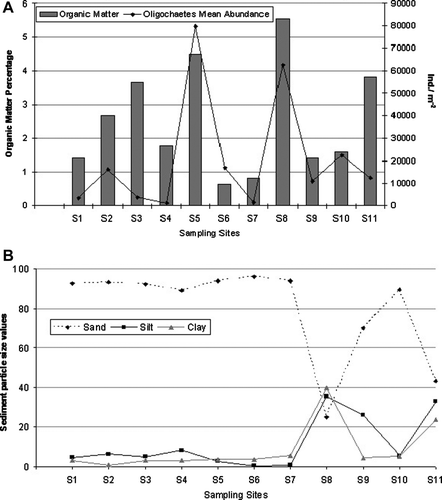
The ANOVA test performed to analyse the spatial variations in individual densities gave statistically significant differences between the sampling sites (P<0.001). Unfortunately, the subsequent test conducted (Student–Newman–Keuls) did not enable us to identify those stations that might have been generating the differences (Underwood Citation2007). Moreover, statistically significant differences in the abundance of oligochaetes throughout the seasons sampled were found (P=0.044). The oligochaete mean density () varied between400 ind./m2 (in spring 2005, at Site 3) and 199,500 ind./m2 (in autumn 2006, at Site 8). At the sampling sites located close to the main sewage discharges of the area (e.g. Sites 5 and 8), the densities of N. variabilis (Site 5 in winter 2005) and C. diastrophus (Site 8 in autumn 2006) both increased. Nais variabilis was furthermore collected at every sampling site and on almost all sampling occasions and its highest densities recorded during winter 2006 in addition to the aforementioned sampling dates. Paranais frici was also collected at all stations, but was found in higher abundance during the winter 2006, particularly at the study sites with settlements of L. fortunei. Chaetogaster diastrophus was registered principally in autumn and spring in the more disturbed localities. Limnodrilus hoffmeisteri was registered at almost all sites during winter and spring 2005, whereas its higher densities were recorded in the spring, especially at Sites 6, 8 and 9. Finally, the Enchytraeidae were recorded at all the sampling sites, but in lower numbers than the other species.
Figure 5
Seasonal distribution and average abundance (ind./m2) of oligochaetes in each sampling locality (1–11) along the Río de la Plata coast. *Samples including settlements of Limnoperna fortunei. ![]()

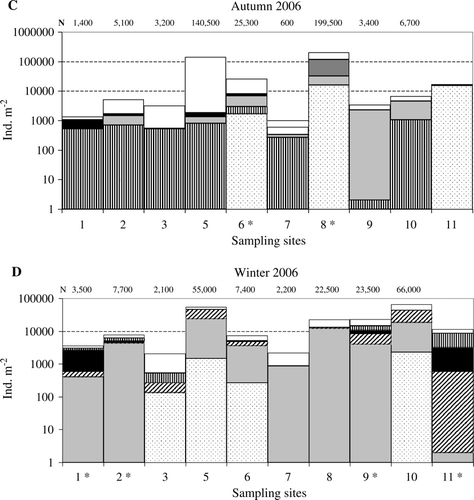
According to the PCA results, the first two axes accounted for 41.8% of the cumulative variance of the dataset. The sampling sites were organised along a eutrophication and pollution gradient (axis 1, eigenvalue: 0.219)—particularity at Sites 4, 5 and 8—and also along a turbidity and conductivity gradient (axis 2, eigenvalue: 0.199)—particularly at Sites 9, 10 and 11 (). The first two axes of the CCA accounted for 41.2% of the cumulative variance in the dataset (axis 1, eigenvalue: 0.191; axis 2, eigenvalue: 0.183). shows the ordination of the oligochaete assemblage with respect to the environmental variables. The variables that best correlated with the CCA axis 1 were: the dissolved-oxygen levels (r=0.5504), the pH (r=0.5374) and NO3 - (r=0.5155). The variables that best correlated with the CCA axis 2 were: the turbidity (r=0.7327) and the conductivity (r=0.4894). Most species were distributed over a wide range of environmental conditions—e.g. N. variabilis, L. hoffmeisteri, P. frici, C. diastrophus and the Enchytraeidae. Especially associated with the nutrient gradients were Limnodrilus claparedianus, Pristina leidyi, Pristina longidentata, Stephensoniana trivandrana, Dero sawayai and Aeolosoma sp.; Limnodrilus udekemianus, Pristina osborni and N. bonettoi were found in association with the turbidity and conductivity gradients.
Discussion
The study area was between the first two sections of the Río de la Plata estuary (cf. Study site); and even though the area is influenced by ocean tides, that segment of the river is usually classified as continental or freshwater. The continuous changes in the water of the Río de la Plata as a result of tidal flows, saline gradients and the type of sediments present directly affect the distribution of the benthic organisms (Boschi Citation1988). In the area studied, we found two gradients—one determined by anthropogenic influences related to pollution and eutrophication and the other related to turbidity and conductivity—varying continuously, but reciprocally, over the length of the river; but with the latter gradient being associated mainly with its tidal dynamic as an estuary (also cf. Gómez et al. Citation2009). From all the variables analysed, the most influential ones in determining the physical and chemical conditions that affected the spatial distribution of the oligochaetes were the turbidity, conductivity, dissolved oxygen, pH and nitrate levels. The abundance of oligochaetes increased together with the ammonium, phosphorus and organic matter. Oligochaete populations respond to changes in the trophic state of the environment, especially when the latter is mainly related to an increase in the deposition of organic matter. Thus, as the conditions deteriorate to reduce the majority of the benthic invertebrates, the abundance of the oligochaetes—especially those that are tolerant to organic pollution, such as N. variabilis and L. hoffmeisteri—correspondingly increases (Moroz Citation1994; Finogenova Citation1996).
The oligochaete assemblages on the banks of the Río de la Plata estuary had been previously studied on the Island Martín García (within the upper section of the river) and on Bagliardi Beach (within the middle section), this last example in association with the invasive mussel L. fortunei (Darrigran et al. Citation1998; Armendáriz & César Citation2001). As in this study, N. variabilis, C. diastrophus, L. hoffmeisteri and the Enchytraeidae had been the dominant species. The species richness, diversity and evenness values were similar to those registered on other occasions along the coast of the Río de la Plata (Darrigran et al. Citation1998; Armendáriz & César Citation2001). In this study, the highest species richness and diversity values could be related to the increased habitat heterogeneity caused by the development of bullrushes and settlements of L. fortunei, with these areas manifesting significantly higher richness and diversity than those sites characterised by sfv. By contrast, the evenness was higher only in the vegetated areas. The microenvironment developed by the byssus of this mussel allows the development of species with an affinity for organic matter and that feed on detritus, bacteria and the faeces of the mollusc (Harper et al. Citation1981ab; Moroz Citation1994), as could be the circumstance for the oligochaetes found in this study. Moroz (Citation1994) similarly found the highest oligochaete abundance and species richness among the byssi of the mussel Dreissena sp. within the silty sands of shallow areas of the Dnieper-Bug estuary.
The oligochaete fauna of the mesohaline part of the estuary studied here appeared similar in species composition and abundance to those of other estuaries (Moroz Citation1994; Finogenova Citation1996; Seys et al. Citation1999). In this investigation, the higher densities were registered during the periods of asexual reproduction in naidine species (not shown). Among the oligochaetes collected, L. hoffmeisteri, N. variabilis and P. frici were found in the upper and middle section of the estuary, thus demonstrating the high tolerance of these species to both poor conditions of water quality (produced by human activities) and saline stress (from the dynamics of the estuary).
Nais variabilis is frequently found in a large variety of habitats, especially those organically enriched, and often in high densities. The density peaks in the winter of 2005 and in the autumn of 2006 were related to a large population increase in this species (as the result of an intense asexual reproduction; not shown) and in that of another naidid, C. diastrophus. Through its feeding habits, N. variabilis is seen as a major consumer of the heterotrophic bacteria associated with organic matter in aquatic sediments. Many naidid species are capable of ingesting a high proportion of bacteria, thus acting as significant detritivores in organically polluted aquatic environments; and those species thus represent a key link in the transfer of food energy to upper trophic levels (Harper et al. Citation1981ab). The higher densities registered for these two species corresponded to those sites with a particularly high contribution of organic matter because of their proximity to sewage discharges (Sites 5 and 8). Gómez et al. (Citation2009) had studied the community of producers (cyanophytes and diatoms) in the same area of the river and during the same seasons as in this work. What would appear to be cause-and-effect relevance is that the peak in the abundance in the two oligochaete species registered here occurred about 4–5 months after the authors had recorded the peak in cell density of the producers. These occurrences might well be related because the two naidine species belong to the functional feeding group known as the gatherer-collectors (Barbour et al. Citation1999), and the producers could be used by them as a food source. Consistent with the dynamics of this lotic system and with the logic of this putative relationship, the peak in abundance of these naidids was recorded some 15 km downstream from the site where Gómez et al. (Citation2009) had cited the maximum cell density of those producers.
Limnodrilus hoffmeisteri is a ubiquitous, eurioic and especially eurihaline species, found very frequently in the basin of the Paraná River, which thrives in thin sediments with abundant organic matter and low dissolved-oxygen levels (Marchese & Drago Citation1992). The species is usually associated with highly polluted environments (Marchese Citation1987; Montanholi-Martins & Takeda Citation1999; Takeda Citation1999; Ezcurra de Drago et al. 2004; Marchese et al. Citation2005). Other authors also recorded L. hoffmeisteri in the shallow organically enriched sediments of lakes (Casellato & Caneva Citation1994) as well as in estuaries, in both the freshwater and brackish sectors (Moroz Citation1994; Finogenova Citation1996; Seys et al. Citation1999). In the Río de la Plata estuary, the anthropogenic input of high quantities of nutrients and organic matter (Sites 4, 5 and 8)—the products of industrial and urban sewage discharges—could favour the development and distribution of eutrophic species such as the ones recorded, in addition to L. udekemianus and L. claparedianus (Moroz Citation1994; Finogenova Citation1996; Seys et al. Citation1999).
Narapa bonettoi is a rheophilic and psammophilic species adapted to environments with both low amounts of organic matter and mobile substrates. This species is frequently found in the main stretch of the Lower Paraguay and Paraná rivers (Paggi et al. Citation1998; Montanholi-Martins & Takeda Citation1999; Ezcurra de Drago et al. 2004; Marchese et al. Citation2005). In the Río de la Plata, this species has been previously recorded in the sandy sediments of the upper section (Armendáriz & César Citation2001; Cortelezzi et al. Citation2007). In this study, N. bonnetoi was registered in the southern locations (Sites 10 and 11), those considered reference sites (because of their relatively undisturbed environments), although in low numbers.
The oligochaete assemblage of this estuary system is highly complex and capable of responding to local changes in the environmental conditions, thus manifesting the ecological plasticity of many of its species with respect to the existing environmental circumstances. In this way, organisms known to be tolerant (Barbour et al. Citation1999)—such as N. variabilis, N. communis, L. hoffmeisteri and the Enchytraeidae—were abundant along the river coast, from the more polluted localities (such as Sites 4, 5 and 8) to those considered as reference locations (Sites 9, 10 and 11), although in the latter stations these indicator species were found to be accompanied by others such as C. diastrophus, P. frici and S. trivandrana. As pointed out by Gómez et al. (Citation2009), descriptive investigations on the spatial and seasonal patterns with respect to the composition of environmentally informative species are useful and essential for ecological–manipulative studies. Our intention in characterising the fauna of oligochaetes and identifying their species-specific responses to environmental variables was to enable a more accurate understanding of those influences that determine their composition within this estuary. These results complement previous findings on this question in freshwater environments and could thus be used for constructing approaches to assessing the ecological status of both estuarine ambients in particular and aquatic ecosystems in general. Finally, the results of this study should provide information for the implementation of the appropriate sustainability-management policies with respect to the Río de la Plata estuary and its tributaries.
Acknowledgements
This research has been financed through a grant from CONICET (PIP No. 5305, PICT No. 32077, Agencia Nacional de Promoción Científica y Tecnológica, FONCYT 2007–2009). We would like to express our thanks to Jorge Donadelli from the Laboratory of Chemistry of the ILPLA for the nutrient and oxygen-demand analysis of the water samples. This Scientific contribution No. 819 was from the Instituto de Limnología Dr Raúl A. Ringuelet. The authors are also grateful to Dr Donald F. Haggerty, a retired career scientist and native English speaker, for editing the final version of the manuscript.
References
- American Public Health Association (APHA) 1998 . Standard methods for examination of water and wastewater . 20th edition . American Water Works Association and Water Pollution Control Federation.American Public Health Association , Washington, DC
- Armendáriz , LC and César , II . 2001 . The distribution and ecology of litoral Oligochaeta and Aphanoneura (Annelida) of the natural and historical reserve of Isla Martín García, Río de la Plata River, Argentina . Hydrobiologia , 463 : 207 – 216 .
- Barbour MT , Gerritsen J , Snyder BD , Stribling JB 1999 . Rapid bioassessment protocols for use in streams and wadeable rivers 2nd edition. EPA 841-B-99-002 Periphyton, benthic macroinvertebrates and fish US Environmental Protection Agency; Office of Water Washington, DC
- Brinkhurst RO , Marchese MR 1992 . Guía para la identificación de oligoquetos acuáticos continentales de sud y centroamérica . Colección Climax No. 6. Santo Tomé, Asociación de Ciencias Naturales del Litoral . Pp. 1 207 .
- Boschi , EE . 1988 . El ecosistema estuarial del Río de la Plata (Argentina y Uruguay) . Anales del Instituto de Ciencias del Mar y Limnología , 15 : 159 – 182 .
- Canevari P , Blanco DE , Bucher EH , Castro G , Davidson I 1999 . Los Humedales de la Argentina: Clasificación, Situación Actual, Conservación y Legislación Wetlands International Publ. 46. 2nd edition Buenos Aires . Pp. 1 208 .
- Casellato , S and Caneva , F . 1994 . Composition and distribution of the bottom oligochaeta fauna of a north Italian eutrophic lake (Lake Ledro) . Hydrobiologia , 278 : 87 – 92 .
- César , II , Ocón , C , Paggi , AC , Rodrígues Capítulo , A , Spaccesi , F , Tangorra , M and Tassara , M . 2000 . Diversidad de invertebrados bentónicos del Río de la Plata . Biología Acuática , 19 : 27 – 63 .
- Cortelezzi , A , Rodrigues Capítulo , A , Boccardi , L and Arocena , R . 2007 . Benthic assemblages of a temperate estuarine system in South America: transition from a freshwater to a estuarial zone . Journal of Marine Systems , 68 : 569 – 580 .
- Darrigran , G , Martín , SM , Gullo , B and Armendáriz , L . 1998 . Macroinvertebrates associated with Limnoperna fortunei (Dunker, 1857) (Bivalvia, Mytilidae) in Río de la Plata, Argentina . Hydrobiologia , 367 : 223 – 230 .
- Darrigran , G and López Armengol , MF . 1998 . Composition, structure and distribution of the malacofauna living on a hard substrate at the Argentinian shore of Río de la Plata . Gayana , 62 : 79 – 89 .
- Erséus , C and Gustavson , L . 2002 . A proposal to regard the former family Naididae as a subfamily within Tubificidae (Annelida, Clitellata) . Hydrobiologia , 485 : 253 – 256 .
- Ezcurra de Drago , I , Marchese , M and Wantzen , KM . 2004 . Benthos of a large neotropical river: spatial patterns and species assemblages in the Lower Paraguay and its floodplains . Archives fur Hydrobiologie , 160 : 347 – 374 .
- Finogenova , NP . 1996 . Oligochaete communities at the mouth of the Neva and their relationship to anthropogenic impact . Hydrobiologia , 334 : 185 – 191 .
- Folk , RL . 1974 . Petrology of sedimentary rocks , 182 Austin : TX, Hemphill Publishing Co. .
- Glasby , CJ and Timm , T . 2008 . Global diversity of polychaetes (Polychaeta; Annelida) in freshwater . Hydrobiologia , 595 : 107 – 115 .
- González-Oreja , JA and Saiz-Salinas , JI . 1999 . Fitting response models of benthic community structure to abiotic variables in a polluted estuarine system . Acta Oecologica , 20 : 471 – 477 .
- Gómez , N and Rodrigues Capitulo , A . 2000 . La Franja Costera Sur del Río de la Plata . Biología Acuática , 19 : 1 – 6 .
- Gómez , N , Licursi , M and Cochero , J . 2009 . Seasonal and spatial distribution of the microbenthic communities of the Río de la Plata estuary (Argentina) and possible environmental controls . Marine Pollution Bulletin , 58 : 878 – 887 .
- Harper , RM , Fry , JC and Learner , MA . 1981a . A bacteriological investigation to elucidate the feeding biology of Nais variabilis (Oligochaeta: Naididae) . Freshwater Biology , 11 : 227 – 236 .
- Harper , RM , Fry , JC and Learner , MA . 1981b . Digestion of bacteria by Nais variabilis (Oligochaeta) as established by autoradiography . Oikos , 36 : 211 – 218 .
- ICZN 2007 . Bulletin of Zoological Nomenclature , Opinion 2167 .
- Kownacki , A . 1971 . Taxocens of Chironomidae in streams of the Polish High Tatra Mts . Acta Hydrobiologica , 13 : 439 – 464 .
- Marchese , MR . 1987 . The ecology of some Benthic Oligochaeta from the Paraná River, Argentina . Hydrobiologia , 155 : 209 – 214 .
- Marchese , M and Ezcurra de Drago , I . 1992 . Benthos of the lotic environments in the middle Paraná River system: transverse zonation . Hydrobiologia , 237 : 1 – 13 .
- Marchese , MR , Wantzen , KM and Ezcurra de Drago , I . 2005 . Benthic invertebrates assemblages and species diversity patterns of the Upper Paraguay River . River Research and Applications , 21 : 485 – 499 .
- Montanholi-Martins , MC and Takeda , AM . 1999 . Communities of benthic oligochaetes in relation to sediment structure in the Upper Paraná River, Brazil . Studies on Neotropical Fauna and Environment , 34 : 52 – 58 .
- Moroz , TG . 1994 . Aquatic Oligochaeta of the Dnieper-Bug Estuary system . Hydrobiologia , 278 : 133 – 138 .
- Organization of American States (OAS) 1971 . Cuenca del Río de la Plata, Estudio para su planificación y desarrollo Inventario y análisis de la información básica sobre recursos naturales Washington, DC . 1 169 .
- Paggi , AC , César , II and Rodrigues Capítulo , A . 1998 . Benthic studies in the zone of islands of Yacyretá prior to impoundment of the Upper Parana River (Argentina) . Verhandlungen International Verein Limnology , 26 : 1089 – 1094 .
- Rodrigues Capítulo , A , César , I , Tassara , MP , Paggi , AC and Remes Lenicov , M . 1998 . Distribution of macrobenthic fauna of the south coastal fringe of the ‘Río de la Plata’ River (Argentine): impact of the urban contamination . Verhandlungen International Verein Limnology , 26 : 1260 – 1265 .
- Rodrigues Capítulo , A , Ocon , CS , Tangorra , M , Paggi , AC , Cortelezzi , A and Spaccesi , F . 2004 . Estudios zoobentónicos recientes en el Río de la Plata . Biologia Acuática , 21 : 19 – 30 .
- Seys , J , Vincx , M and Miere , P . 1999 . Spatial distribution of oligochaetes (Clitellata) in the tidal freshwater and brackish parts of the Schelde estuary (Belgium) . Hydrobiologia , 406 : 119 – 132 .
- Shannon , CE and Wiener , W . 1963 . The mathematical theory of communication , 1 – 125 . Urbana, IL : Illinois University Press .
- ter Braak , CJF and Verdonschot , PFM . 1995 . Canonical correspondence analysis and related multivariate methods in aquatic ecology . Aquatic Sciences—Research Across Boundaries , 57 : 255 – 289 .
- Takeda , AM . 1999 . Oligochaete community of alluvial Upper Paraná River, Brazil: spatial and temporal distribution (1987–1988) . Hydrobiologia , 412 : 35 – 42 .
- Underwood , AJ . 2007 . Experiments in ecology. “Their logical design and interpretation using analaysis of variance , 1 – 504 . Cambridge : Cambridge University Press .
- Urien , CM . 1967 . Los sedimentos modernos del Río de la Plata Exterior . Boletín del Servicio de Hidrografía Naval , 4 : 113 – 213 .
